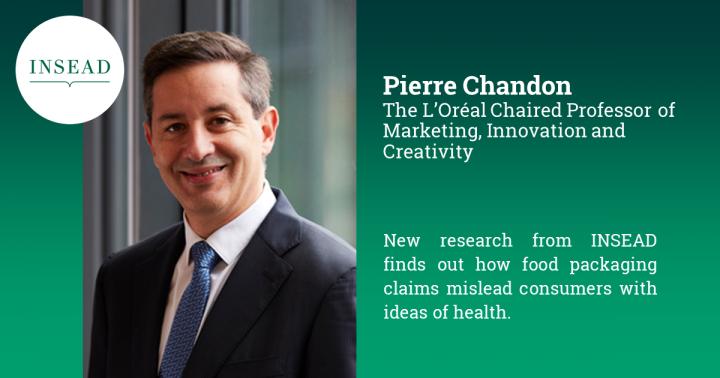Research finds four distinct ways that food brands claim to be ‘healthy’ and how those types of claims influence consumers’ expectations and choices for breakfast cereals, despite not being linked to the actual nutritional quality of the product

Credit: INSEAD
Researchers have found that the type of healthy claims on certain food products can be completely uncorrelated with actual nutritional quality. Yet these messages directly influence consumers’ expectations of taste, healthiness and fattening consequences of their food, as well as food choices.
These findings are featured in the paper “Healthy Through Presence or Absence, Nature or Science? A Framework for Understanding Front-of-Package Food Claims” by Pierre Chandon, the L’Oréal Chaired Professor of Marketing, Innovation and Creativity at INSEAD, Quentin André, Assistant Professor of Marketing at Rotterdam School of Management and Kelly Haws, the Anne Marie and Thomas B. Walker, Jr. Professor of Marketing at the Owen Graduate School of Management, Vanderbilt University. Their article was published in the April 2019 issue of the Journal of Public Policy & Marketing.
Across four studies, Chandon and his co-authors developed and tested a classification of front-of-pack claims, established the disconnect between nutritional profile and the front-of-package claims on breakfast cereals and milk products, and how the types of claim predict consumers’ choices between different foods with or without food claims. For an idea of the scope, in the 633 breakfast cereals included in one of their studies, 460 had a health or nutrition claim on the package.
Claims don’t equal nutrition
The researchers show that front-of-package food claims typically take shape across two dimensions:
- 1) Science (“improved”) or natural (“preserved”) arguments.
2) Presence of positive attributes or absence of negative attributes.
This creates four distinct types of claims:
- Adding positives – examples are “high calcium”, “probiotics”, “high vitamins”, “high protein”
- Removing negatives – examples are “gluten-free”, “low salt”, “low cholesterol”, “light”
- Not adding negatives – examples include “no artificial flavour”, “no preservatives”, “GMO-free”, “no pesticides”
- Not removing positives – examples are “all natural”, “homemade”, “pure”, “fresh”
These claims influence perceptions, even when there is no link to actual nutritional quality.
The influence of goals
Chandon said, “We found that consumers had a more positive attitude toward claims that are based on the presence of something good, compared to claims that are about the absence of something bad. For example, people expected breakfast cereals with both ‘adding positives claims’ (‘high protein’, ‘high fiber’) and ‘not removing positives claims’ (‘all natural’, ‘made with whole grains’ , ‘wholesome’) to be healthier than brands with claims about ‘removing negatives claims’ or ‘not adding negatives claims’, even if the messages claimed the absence of something considered to be harmful.”
Respondents felt more strongly about nature-based, presence-focused foods health claims. When consumers see nature-focused claims of health, like “homemade” or “no preservatives”, they believe the food is tasty. Finally, if the claim removes negatives (“light”, “low-fat”, “low calorie” or “low-sugar”), consumers believe that the breakfast cereal helps weight loss or weight maintenance.
Although there was no link between the type of claim and overall nutrition quality for breakfast cereals, consumers expected the type of claim to be a strong predictor of the healthiness, taste and dieting properties of the products. None of the claims the researchers surveyed explicitly said that the product would make people healthier (or help them lose weight or stay thin), yet consumers interpreted these claims as such. And their perceptions influenced their choices.
One study gave participants one of three goals – healthy eating, hedonic eating or weight-loss – to see how the type of claim helps predict consumers’ choices between different foods with or without food claims. Consumers who have a goal to lose or maintain weight strongly prefer claims that remove negatives (“low fat”) unlike those who are interested in healthy eating or eating for enjoyment who favour nature-based claims.
Implications
“To our surprise, the correlation between the type of ‘healthy’ claim made and the actual nutritional quality of the breakfast cereal was almost zero (0.04) to be precise),” Chandon said.
As people are moving away from nutrition-based to nature-based approaches to “healthy” eating, so are food claims. “This should raise alarm bells for regulators,” commented Chandon. “The first principle of regulating marketing claims is to ensure messages are accurate, but policymakers need to go further. Marketing claims must not only be accurate, they should not be misleading in such a way that consumers expect benefits that a product does not deliver.”
The researchers also suggest that marketing departments that care about ethics in organisations would do well to heed the findings of the research so that they do not inadvertently mislead consumers. This framework can help consumer researchers, public policy makers and marketing practitioners to better predict consumers’ perceptions of health claims and their subsequent food choices.
###
Media Contact
Chris Howells
[email protected]
Original Source
https:/
Related Journal Article
http://dx.




